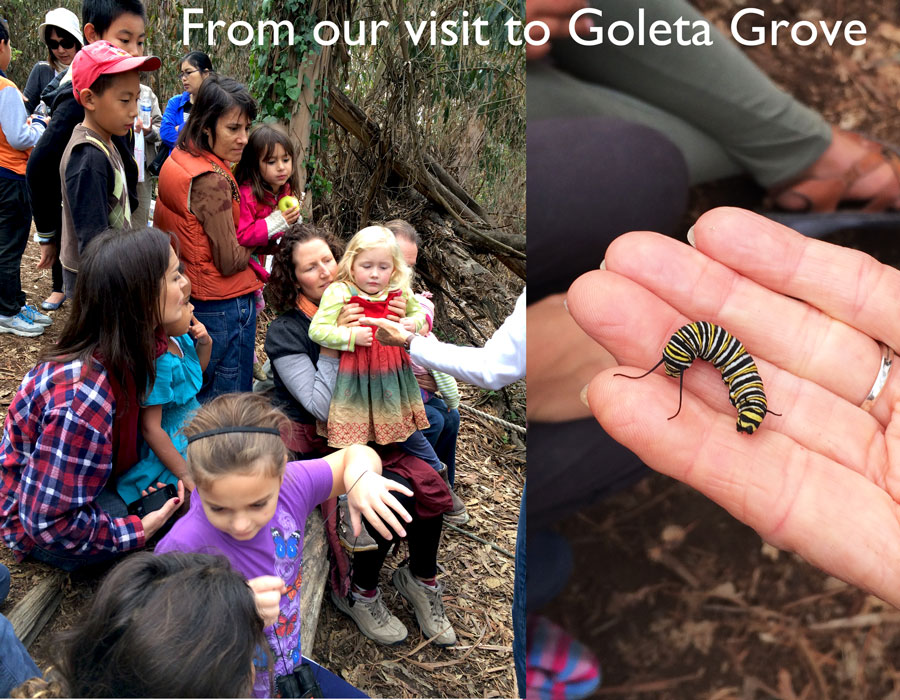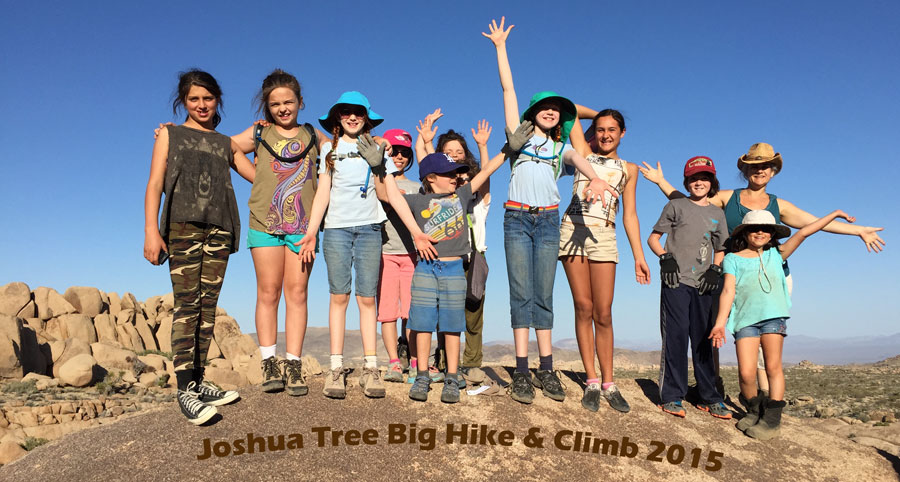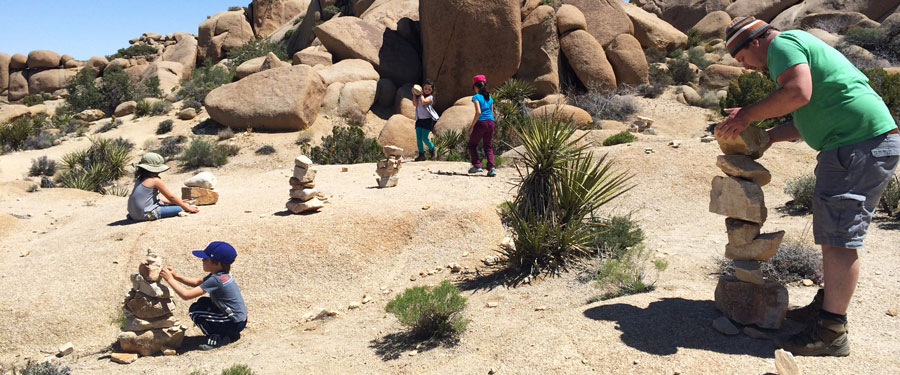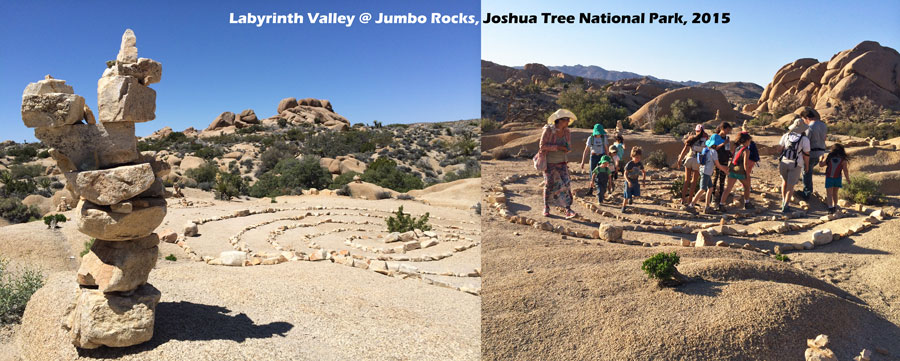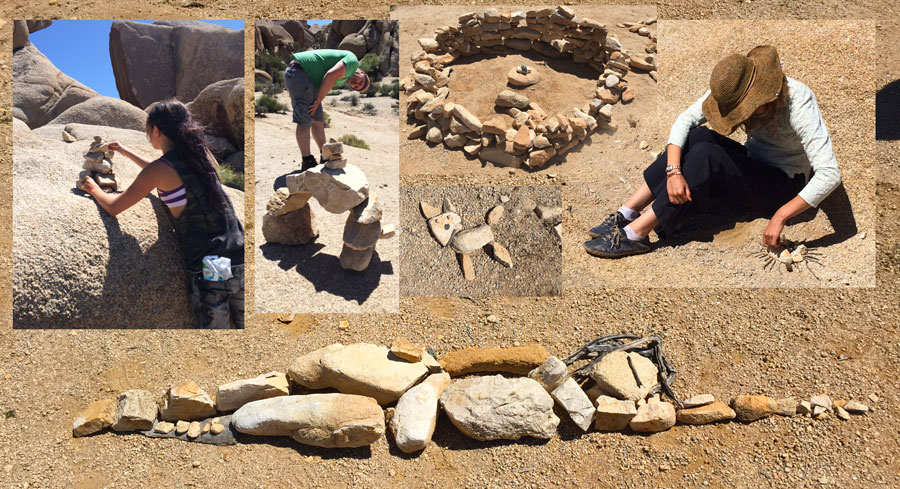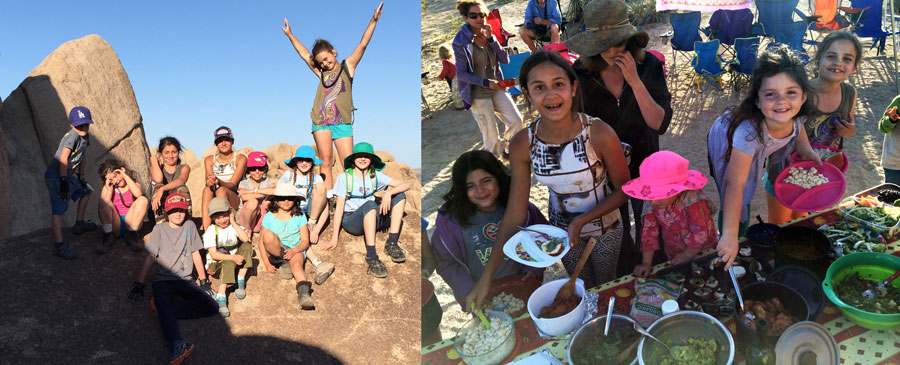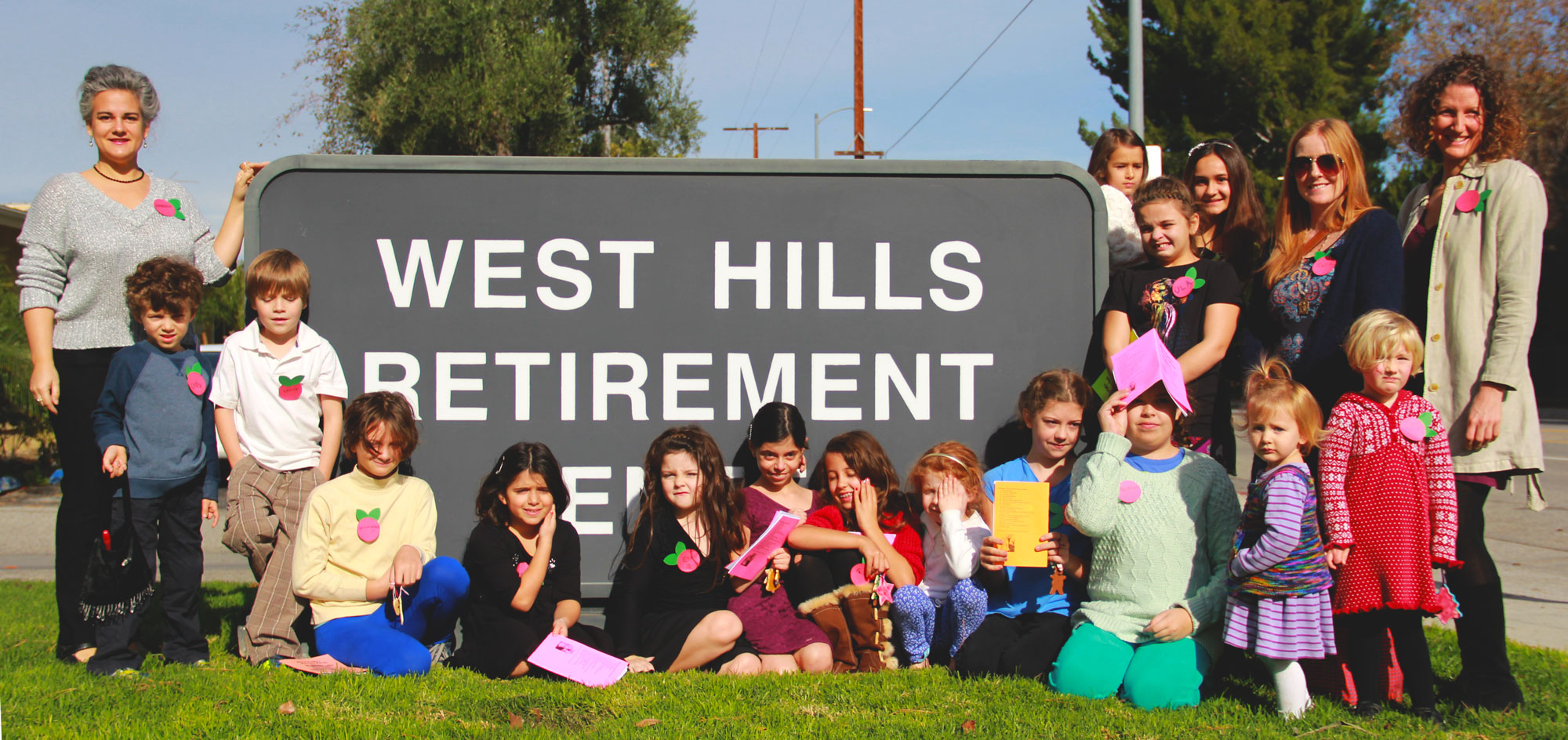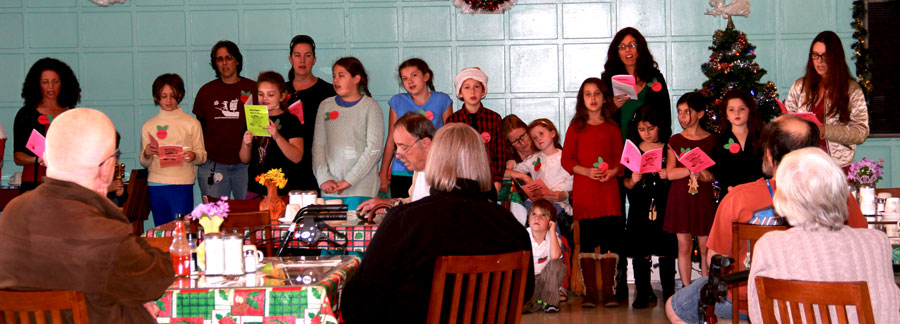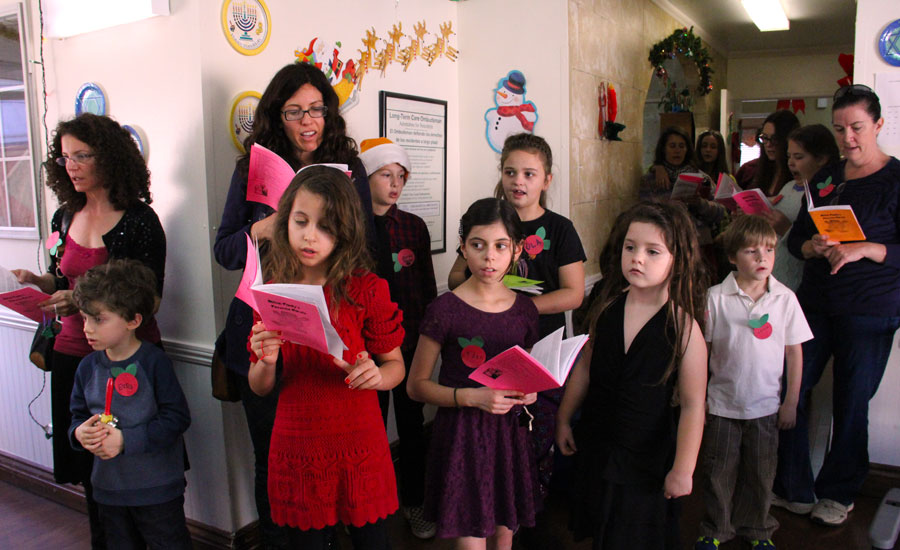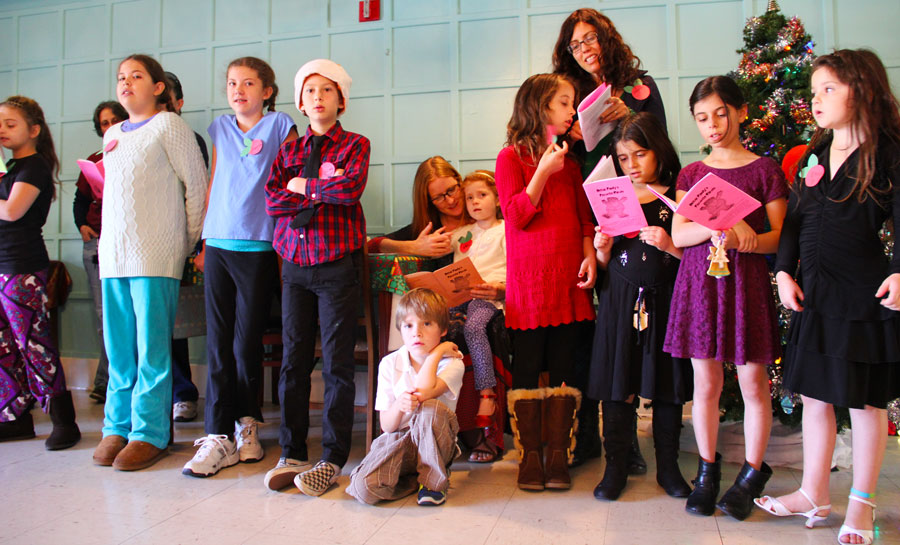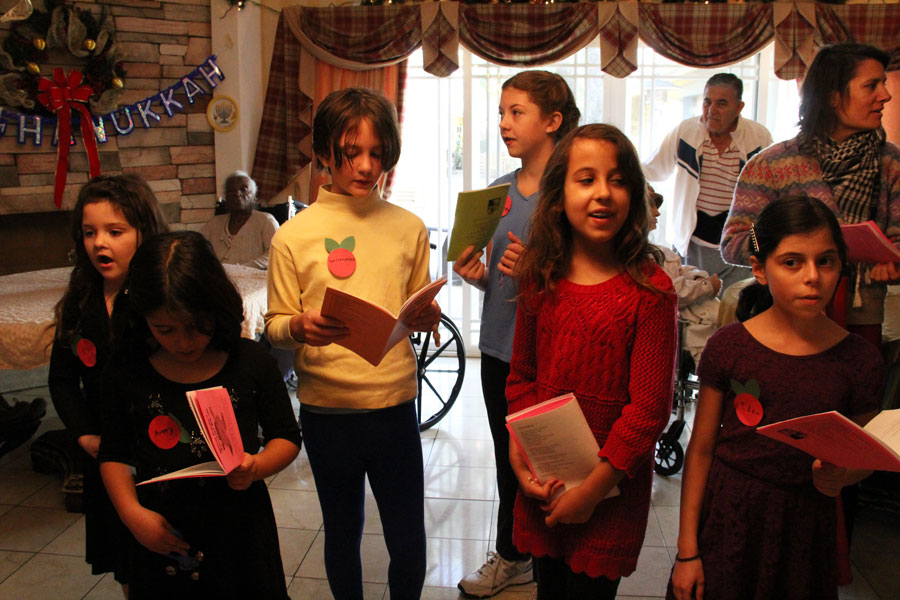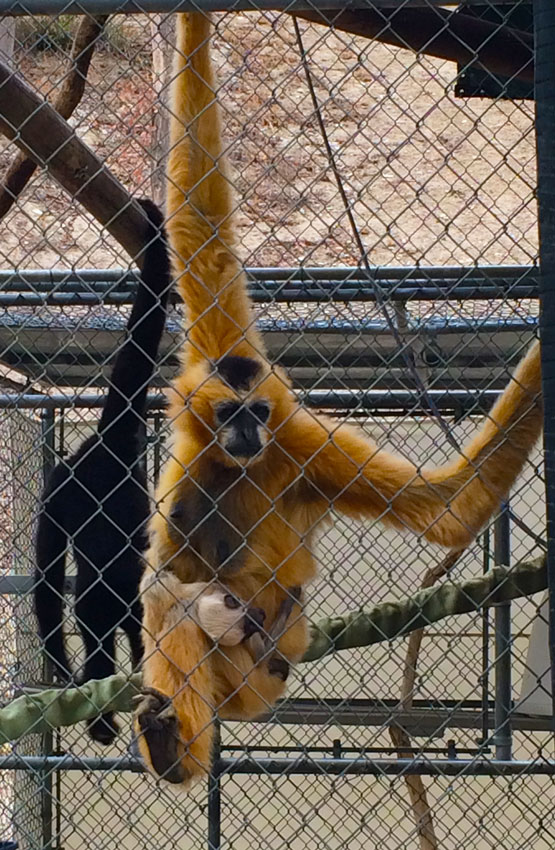 Only a mere 3 hour drive from Los Angeles, Joshua Tree National Park is an amazing way to experience the rich life of the Mojave Desert. April is a great time to see the ground covering flowers, the blossoming pre-historic Joshua Trees, and the dramatic night skies with minimal light pollution. It’s also a great place to Hike, Explore and Bond with your family and fellow homeschooling friends. I’ve been hosting this campout in Joshua Tree since 2009, seven years ago! And this year was one of the best! Take a look at our Magic.
Only a mere 3 hour drive from Los Angeles, Joshua Tree National Park is an amazing way to experience the rich life of the Mojave Desert. April is a great time to see the ground covering flowers, the blossoming pre-historic Joshua Trees, and the dramatic night skies with minimal light pollution. It’s also a great place to Hike, Explore and Bond with your family and fellow homeschooling friends. I’ve been hosting this campout in Joshua Tree since 2009, seven years ago! And this year was one of the best! Take a look at our Magic.
]]>
What to bring: Pen or pencil for each child and something like a book to make writing and drawing on my scavenger hunt sheet easier.
Bring Picnic Lunch or buy something at their CrossRoads Cafe adjacent to the courtyard.
Estimated timeline
Part A: 30-45 mins [...]]]>
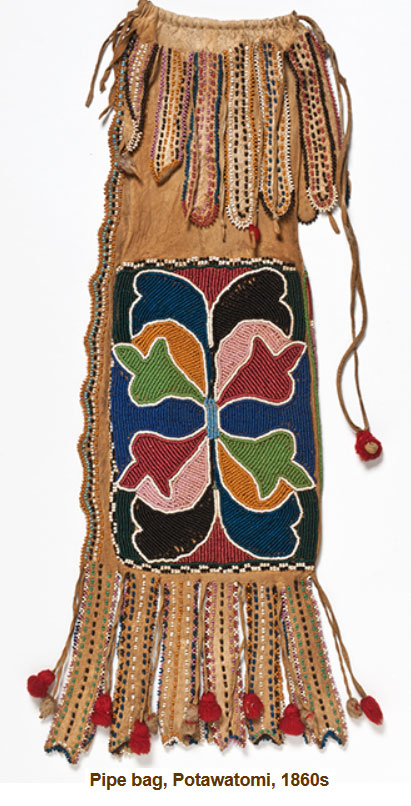 Fieldtrip Location: Autry Museum, 4700 Western Heritage Way, Los Angeles
Fieldtrip Location: Autry Museum, 4700 Western Heritage Way, Los Angeles
What to bring: Pen or pencil for each child and something like a book to make writing and drawing on my scavenger hunt sheet easier.
Bring Picnic Lunch or buy something at their CrossRoads Cafe adjacent to the courtyard.
Estimated timeline
Part A: 30-45 mins – Native North American Bead Exhibit (Exhibit lasts from March 15, 2014–April 26, 2015). After we pay at the front desk, I will walk everyone to the Native American Bead exhibit.
I’ll talk for about 5-10mins before letting the kids scurry about the exhibit with their scavenger hunts. Kids can work solo, with friends or teams.
10-15 minutes later I will walk through the exhibit and discuss items based on what they all found in the scavenger hunt.
Part B: 10 mins – CULTURE CLASH: Westward Expansion through the Native American Lens
Nearby exhibit of local Middle school students who painted before and after images of Native people and boarding schools.
This room is actually is an open balcony overlooking the museum’s waterfall in the back courtyard.
 Part C: 15-30 mins – Downstairs Exhibit Anyone who is interested can follow me to the Native exhibit downstairs that has an original Ledgerbook piece on display by Howling Wolf and artifacts from boarding schools. There is a stuffed Buffalo/bison & hands on exhibits on Plains Indians.
Part C: 15-30 mins – Downstairs Exhibit Anyone who is interested can follow me to the Native exhibit downstairs that has an original Ledgerbook piece on display by Howling Wolf and artifacts from boarding schools. There is a stuffed Buffalo/bison & hands on exhibits on Plains Indians.
At any time after the Scavenger hunt families can walk through the rest of the museum at your leisure.
Part D: Consider stopping at the Autry Store Giftshop on your way out. They have a great selection of books for young and old. This is where I got our family’s copy of the book: The Ledgerbook of Thomas Blue Feather. And in the store there are a few original artpieces of contemporary ledgerbook art by living Native Americans artists.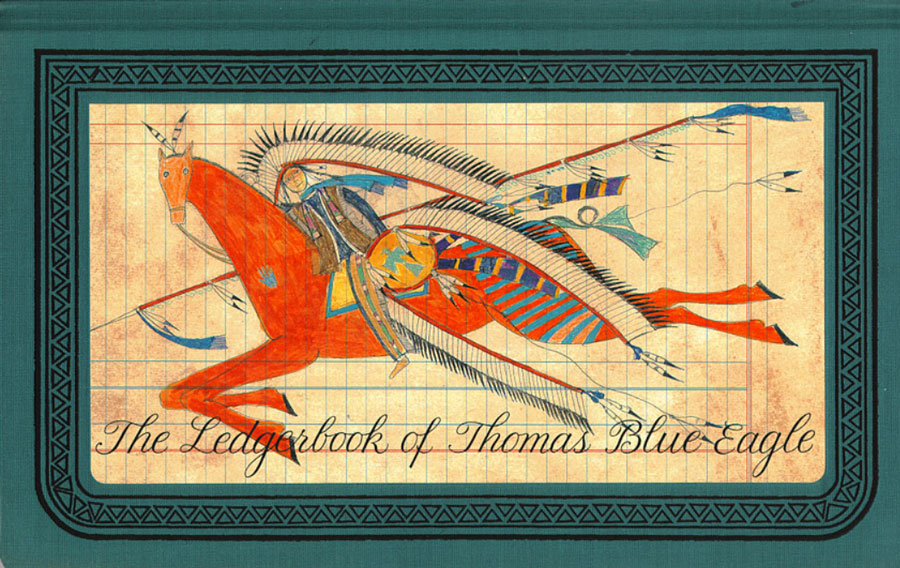
]]>
I will bring [...]]]>

I will bring paper and scissors to make snowflakes.

Maybe they can gift it to someone during the holidays. Sky is the limit. We are a crafty bunch.
I can’t wait to see what you bring.
Deltacs will be bringing paints and glitter for kids to help us paint salt dough ornaments that we annually hand out to residents of retirement homes on Monday Dec 15th! We will be singing carols to the residents and you are welcome to join us. Click on the link above to make your own at home.

And don’t forget our Holiday Party & Potluck is December 18th. A potluck for lunch 11:30-1pm and then a celebration of Hanukkah, Kwanza, Christmas, St. Lucia and more.


]]>

During our visit, my family lit candles at the Hsi Lai Temple last week in Hacienda Heights as they prepared for the Lunar New Year
Let’s Celebrate the New Year with stories, games and crafts! The children will get a chance to act out the story of How the twelve Animals were chosen for the Chinese Zodiac Calendar. 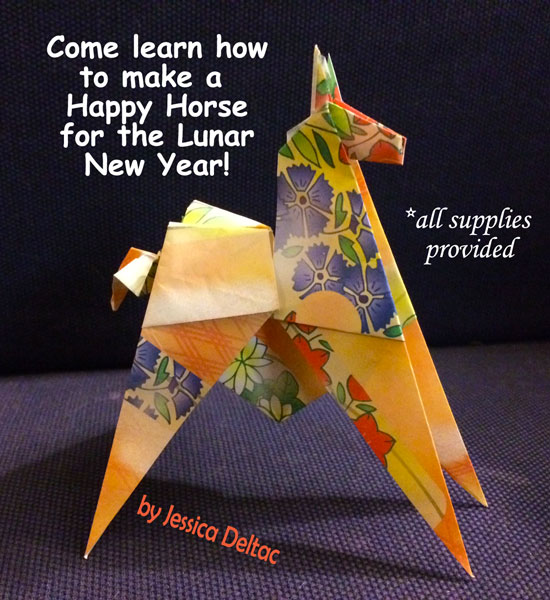 Only 12 animals made the cut. From Jan 31 on in 2014, it will be the Year of Horse. I will teach how to make an Origami Horse. (Esme is thrilled to teach how to make a bunny or a duck from Origami paper. Ula will happily show anyone how to make a box bottom and lid from paper). I will provide the Origami paper. This is included with the monthly family dues of $5 per family.
Only 12 animals made the cut. From Jan 31 on in 2014, it will be the Year of Horse. I will teach how to make an Origami Horse. (Esme is thrilled to teach how to make a bunny or a duck from Origami paper. Ula will happily show anyone how to make a box bottom and lid from paper). I will provide the Origami paper. This is included with the monthly family dues of $5 per family.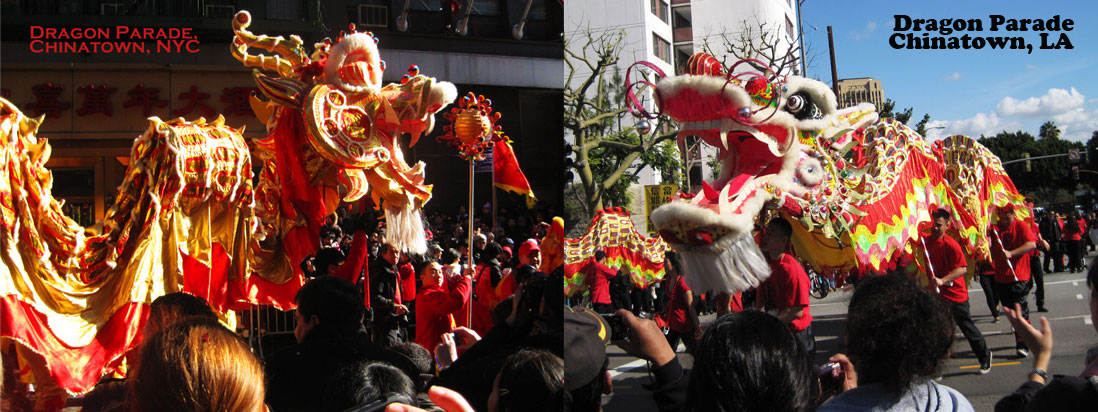
Anyone who wishes to attend a Real Chinese New Year celebration should go to either of these upcoming celebrations: LA’s 115th Golden Dragon Parade in Chinatown at Hill Street at Temple (Feb 1st) and Vietnamese Tet at Whittier Narrows Park (Feb 15th/16th).
We will learn about some traditions that bring fortune and happiness to homes and family for New Year. I will help teach everyone how to play the Traditional Korean New year’s game – Yut-No-Ri. It is so fun and very simple. I will bring supplies for anyone who wants to make their own Yut game to take home.
 Another craft/tradition everyone can create will be to color in the copies of Chinese Gods to color in and auspicious Chinese words to decorate your home for the Lunar New Year. One such god is the Kitchen God – Zao Jun. He is put up somewhere near your stove
Another craft/tradition everyone can create will be to color in the copies of Chinese Gods to color in and auspicious Chinese words to decorate your home for the Lunar New Year. One such god is the Kitchen God – Zao Jun. He is put up somewhere near your stove and as the kitchen is a center for house activities, he records all year long the goings on in the household. He is released to the Heavens (released by your family burning his image). He reports how well your family has acted all year long to the Jade Emperor (a bit like the Elf on the Shelf, but all family members are held accountable). The Jade emperor evaluates what your family deserves fo the upcoming year. And the family puts a new image of Zao Jun, the Kitchen God up on New Year’s Day.
and as the kitchen is a center for house activities, he records all year long the goings on in the household. He is released to the Heavens (released by your family burning his image). He reports how well your family has acted all year long to the Jade Emperor (a bit like the Elf on the Shelf, but all family members are held accountable). The Jade emperor evaluates what your family deserves fo the upcoming year. And the family puts a new image of Zao Jun, the Kitchen God up on New Year’s Day.

Here we are in front of 2 fully restored P-51 Mustangs (and pilot). Introduced in 1942, these “Cadillacs of the Sky,” were the swiftest, most maneuverable planes in WWII combat dogfights. Over 14,000 were built and less than 100 remain. The museum sent us over to the Santa Monica Municipal Airport to catch a glimpse before we took our tour. It was a fluke that “February” and “Bum Steer” were there at all. 
This was especially relevant for my daughters, whose American great-grandfather pilot, Jackson Clary (far right), flew numerous missions in this Halifax bomber DK259. On Sept 29, 1943, German night-fighter-pilot Prinz zu Lippe-Weissenfeld attacked the bomber from below. Due to the damage, Clary soon ordered his six crewmen to parachute out as he crash-landed the flaming fighter plane. Not knowing if they landed on enemy lines or not, the survivors owe their lives to the brave families in the once dutch town of Boekelo (present day Netherlands) that aided the Americans. Last fall, on the 70th anniversary of that crash, the town hosted descendants of the crew (including my Sister-in-law) to erect a monument in their honor.
Below on the left is the P-51 called “February,” and it had the docents at the museum in a flurry of excitement to get to see it. Not only is February fully-restored mechanically, but her exterior is as it was during flight in WWII w hen it was flown by Capt. Jim Brooks, survivors who are both main characters in the documentary, Gray Eagles which we got to see just before we left the Museum.
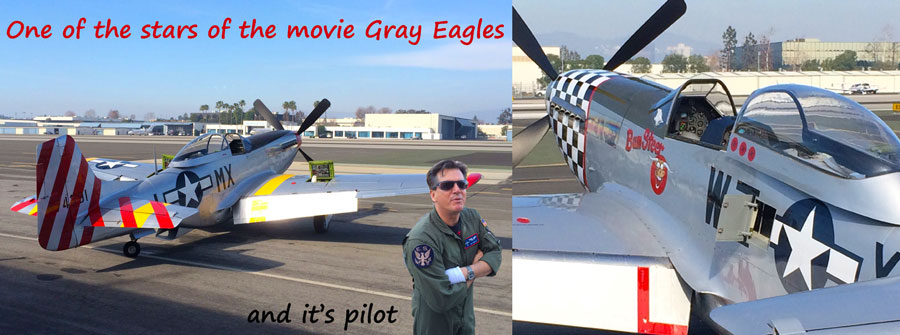
The P-51 on the right, “BumSteer” was restored and modified so either person in front or back has a stick to steer the plane. The three red swastika’s circles denote the number of Nazi planes it shot down. The pilot was very indulgent to answer most of our questions. “They can reach a ceiling of 42,000 feet… people don’t know how many parts were made to supply the original 14,000…this is the time of year we train for the airshow we perform… three of us fly in a “V” formation with our wings closer than they are parked on the tarmac right now…”
Time to get to our tour at the Museum of Flying.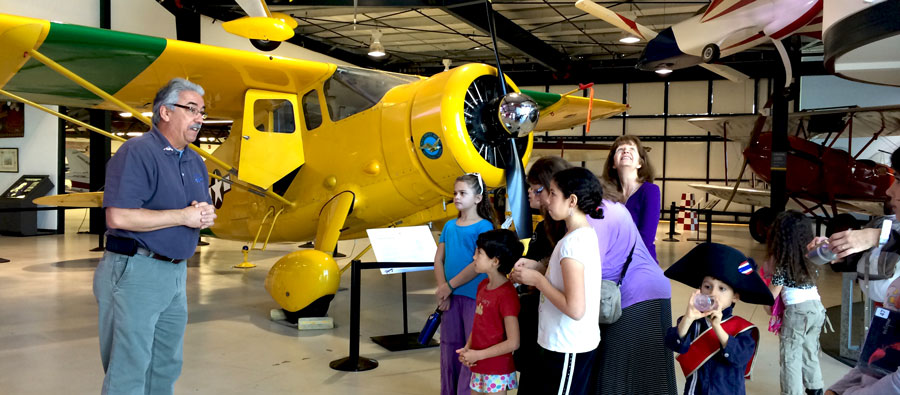
Our fabulous tourguide Steve, at the Museum of Flying in Santa Monica intrigued and captivated us all.
 On the right a basket from a Hot Air Balloon since the first manned flight was by the French Montgolfier brothers 1783, earning their father a title from Louis XVI. This replica of the Wright brothers’ plane was also a movie star. It was created for and flown in the movie: Night at the Museum: Battle of the Smithsonian.
On the right a basket from a Hot Air Balloon since the first manned flight was by the French Montgolfier brothers 1783, earning their father a title from Louis XVI. This replica of the Wright brothers’ plane was also a movie star. It was created for and flown in the movie: Night at the Museum: Battle of the Smithsonian. 
This one above is a Yak 3, a Russian combat airplane from WWII. This actual plane has 14 registered victories from the war as denoted by the stars on the right. And yes, that is wood exposed on the end of the wing, as that is what the interior was composed.
 The only other replica in the museum beyond the Wright Bros, was this red one, all the others were once or still are active flying planes. This was a replica of Amelia Earhart’s plane that she flew that made her famous for being the 1st woman to fly solo from the East to West Coast. Part of her notoriety was due in part to her bank account. Most women couldn’t afford to cover petrol and maintenance costs let alone buy their own airplane like Earhart. The museum emphasized the WASPS and other Female Pioneers of Flight. Women like Blanche and Florence were not solvent enough to buy their own planes, but broke records anyhow. They were at the mercy of the people who funded the Barnstorms and other aeronautic events.
The only other replica in the museum beyond the Wright Bros, was this red one, all the others were once or still are active flying planes. This was a replica of Amelia Earhart’s plane that she flew that made her famous for being the 1st woman to fly solo from the East to West Coast. Part of her notoriety was due in part to her bank account. Most women couldn’t afford to cover petrol and maintenance costs let alone buy their own airplane like Earhart. The museum emphasized the WASPS and other Female Pioneers of Flight. Women like Blanche and Florence were not solvent enough to buy their own planes, but broke records anyhow. They were at the mercy of the people who funded the Barnstorms and other aeronautic events.

And if this wasn’t all enough, after we left the museum for a nearby park to picnic Ula shouted “Look UP!!” We had the added bonus of seeing five airplanes SKYWRITING in circles around us! Yet another bonus for our fieldtrip!! It was Shia LaBoeuf’s high-priced apology for plagiarism ($25,000) – 5 glints of light (airplanes from our far distance) flying in synchronized fashion wrote #STOPCREATING almost a dozen times. What a fabulous day with wonderful people (shout out to Linda!).
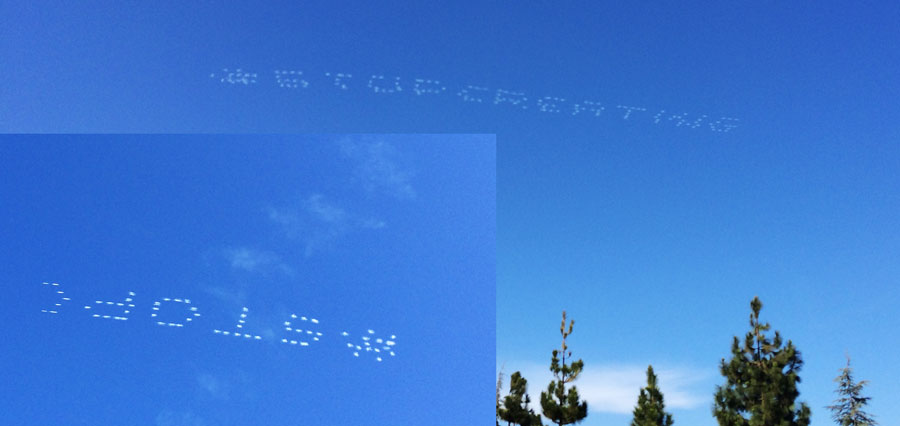
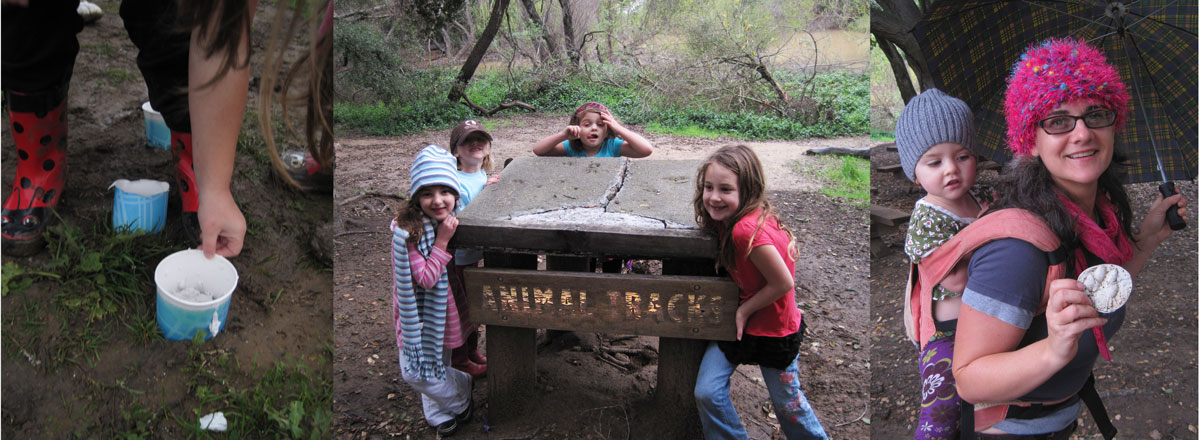 How do you raise a Conservationist? You first spend time outdoors. You listen to what you can hear. You watch what life is around you: ants and pillbugs; birds trilling calls and cawing warnings; patterns in clouds in the morning, afternoon and evening; and more. Spending time in Nature creates awareness and compassion for the world about us. Fortunately for my family, there is alot of nature available in our area.
How do you raise a Conservationist? You first spend time outdoors. You listen to what you can hear. You watch what life is around you: ants and pillbugs; birds trilling calls and cawing warnings; patterns in clouds in the morning, afternoon and evening; and more. Spending time in Nature creates awareness and compassion for the world about us. Fortunately for my family, there is alot of nature available in our area.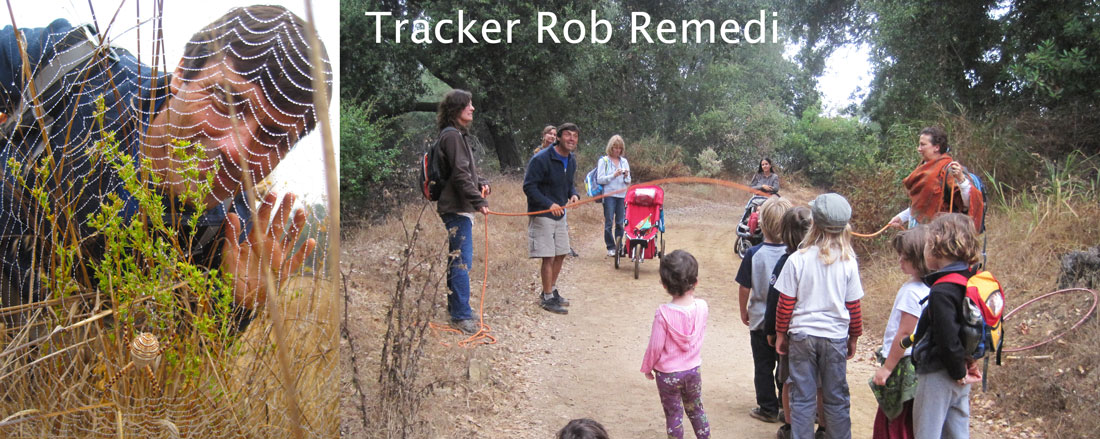
Even though we don’t live IN Topanga, many of our friends do and some of our happiest moments in California have taken place in and about Topanga canyon. This is why over the past 5 years, we have been involved in many events to help keep Topanga’s Web-of-Life intact. On Topanga Earthdays we’ve helped  clean out the watershed of debris and invasive plants; we have taken many conservation “walk-abouts” with Tracker Rob, and then with the Tree people we have taken out invasive plants and planted indigenous species. As members of the Topanga Wildlife Youth Group, my children were part of a sacred red-tailed hawk release as well as helped biologists record, research and remove
clean out the watershed of debris and invasive plants; we have taken many conservation “walk-abouts” with Tracker Rob, and then with the Tree people we have taken out invasive plants and planted indigenous species. As members of the Topanga Wildlife Youth Group, my children were part of a sacred red-tailed hawk release as well as helped biologists record, research and remove  invasive crayfish from the Topanga creek. Find out a way that you can get involved to help protect your environments and the your personal web-of-life. Your family will have a sense of pride and an added connection to the world outdoors. This is one of the best ways to prevent cynicism and complacency from taking hold of a human being. You need not look further than the faces in these photos to find proof.
invasive crayfish from the Topanga creek. Find out a way that you can get involved to help protect your environments and the your personal web-of-life. Your family will have a sense of pride and an added connection to the world outdoors. This is one of the best ways to prevent cynicism and complacency from taking hold of a human being. You need not look further than the faces in these photos to find proof.

I would like to take this moment to offer my love and gratitude for you, my community. I am so thankful to share our form of village -lifestyle with each of you. With out being surrounded by like-minded families on fieldtrips, at my weekly parkdays or in this cyber-community, I would not have such a fulfilling life. Thank you. May each of you relish in the connections of your family and friends during this week of Thanks.
 Other Fall Celebrations:To keep the emphasis away from the commercial aspects of the upcoming holidays, my family has been spending time discussing the history and purpose of Harvest Festivals from other cultures: Yam Festival-Nigeria & Ghana, Pongal Rice Festival- India, Sukkot-Hebrew, Moon Festival- China. I chose these above links for their kid-friendly explanations of these festivals of thanks. There are both recipes and crafts in the book We Gather Together as well as a great explanation to how our orbit around the sun affects our (growing) seasons.
Other Fall Celebrations:To keep the emphasis away from the commercial aspects of the upcoming holidays, my family has been spending time discussing the history and purpose of Harvest Festivals from other cultures: Yam Festival-Nigeria & Ghana, Pongal Rice Festival- India, Sukkot-Hebrew, Moon Festival- China. I chose these above links for their kid-friendly explanations of these festivals of thanks. There are both recipes and crafts in the book We Gather Together as well as a great explanation to how our orbit around the sun affects our (growing) seasons.
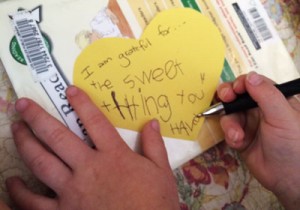 Focus on Thanks On their own, in preparation for spending Thanksgiving with friends, my daughters have borrowed an idea from Valentines day for a new tradition. They have created an envelope for each person to be seated at the table and personalized them with photos and
Focus on Thanks On their own, in preparation for spending Thanksgiving with friends, my daughters have borrowed an idea from Valentines day for a new tradition. They have created an envelope for each person to be seated at the table and personalized them with photos and 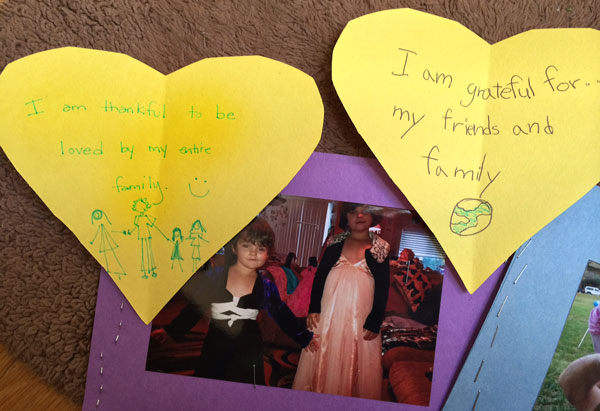 drawings. Through out our day together, each person will be invited to write on a heart shaped paper what they like about that person or are just grateful for and place it in someone’s envelope. The envelopes will get fuller and fuller until we reconvene for dessert. Ideally, everyone will take turns reading a few outloud. I can not wait!! A list of craft ideas for Thanksgiving.
drawings. Through out our day together, each person will be invited to write on a heart shaped paper what they like about that person or are just grateful for and place it in someone’s envelope. The envelopes will get fuller and fuller until we reconvene for dessert. Ideally, everyone will take turns reading a few outloud. I can not wait!! A list of craft ideas for Thanksgiving.
Hanukkah starts this week too. Even though we are not Jewish, during Hanukkah, we reflect upon the story of Antiochus IV, in 167 BCE, razing the temple in Jerusalem and the miracle one day’s worth of oil lasting eight days. In a craft and storybook of Hanukkah we got from our library, we learned that a gift of a Samsa (hand-shaped) candle is given to children in Syria during Hanukkah to honor the fortitude and luck of the Jewish in relocating to countries like Syria and Morocco after the expulsion of Jews from Spain in 1492 by the Alhambra Decree.
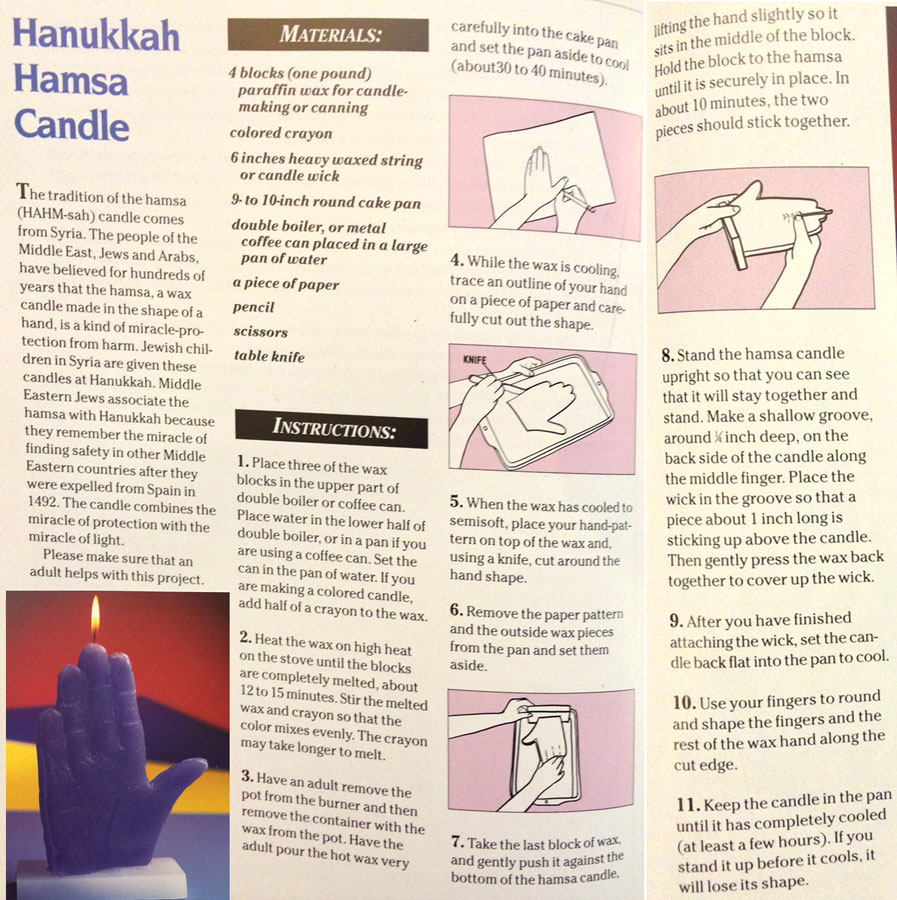
To protect your cake pan, be sure to cover it with foil or parchment paper before pouring out the wax.
….I believe that the best time to share historical and cultural connections is while leisurely making theme-related crafts. While we make our Samsa candle, we will most probably be discussing why people can’t all get along and how that is different from why kings and presidents make people leave their lands. How would we have solved the problems of Antiochus or Isabella & Ferdinand? What is something positive about moving to a different land. What else was going on in Europe in 1492?
Museum Member Appreciation Days Nov 29, 30 & Dec 1 - Looking for a healthier alternative to Black Friday? If you have a membership to any of 16 area museums (Skirball, Kidspace, MOCA etc), you can take your family to any others for free. Plus save a bonus 20% off anything in their giftshops. Since LA is our classroom, part of our school budget goes to memberships to museums like Skirball and Natural History Museum. Reciprocal benefits like this add to the value.
Mark your Calendar for Dec 14,15, 20, 21, & 22. Just a note that, “Back to Bethlehem” 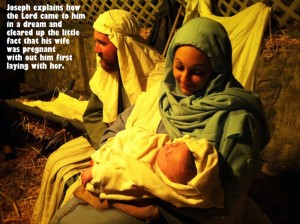 in Chatsworth has returned, but to a new location.
in Chatsworth has returned, but to a new location. 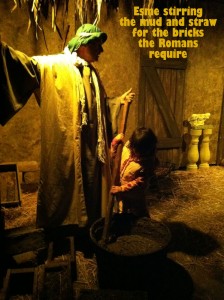 This is my family’s favorite living history event, because it takes place at nighttime. Come experience a living history with the birth of Jesus, Roman Centurions and the villagers of Bethlehem circa 0 AD, BC, CE or BCE. I’m hoping that St. Stephens Church that inherited this tradition will pull off as a phenomenal of an experience as the Church at Rocky Peak created. We’ve been going since 2006.
This is my family’s favorite living history event, because it takes place at nighttime. Come experience a living history with the birth of Jesus, Roman Centurions and the villagers of Bethlehem circa 0 AD, BC, CE or BCE. I’m hoping that St. Stephens Church that inherited this tradition will pull off as a phenomenal of an experience as the Church at Rocky Peak created. We’ve been going since 2006.  We look forward to the homemade baked cookies and hot chocolate on the way out; Jane, the sweetest camel you will ever be near; the goat cheese on crackers and pomegranate seeds; the weaving crafts, apprenticing with word and brick workers; asking Mary if she like nursing the baby (Esme’s classic question 3 years ago) and the sighting of angels on the hill on each half hour.
We look forward to the homemade baked cookies and hot chocolate on the way out; Jane, the sweetest camel you will ever be near; the goat cheese on crackers and pomegranate seeds; the weaving crafts, apprenticing with word and brick workers; asking Mary if she like nursing the baby (Esme’s classic question 3 years ago) and the sighting of angels on the hill on each half hour.
There is a new Location 20121 Devonshire St, Chatsworth, CA. 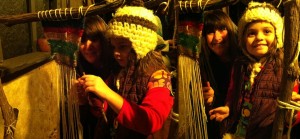 Also new, is the suggested donation of $2/person over 5 years of age (and a max of $10/family). It used to be free, but I have no problem supporting this experience. I will also say, we have never felt any pressure of any religious nature in the past. I wouldn’t feel comfortable if it felt “too preachy.” 7pm-9pm Sat & Sun December 14th and 15th and Fri, Sat & Sun December 20-22. We usually arrive about 6:30, 6:45 to get through the line sooner than later.
Also new, is the suggested donation of $2/person over 5 years of age (and a max of $10/family). It used to be free, but I have no problem supporting this experience. I will also say, we have never felt any pressure of any religious nature in the past. I wouldn’t feel comfortable if it felt “too preachy.” 7pm-9pm Sat & Sun December 14th and 15th and Fri, Sat & Sun December 20-22. We usually arrive about 6:30, 6:45 to get through the line sooner than later.
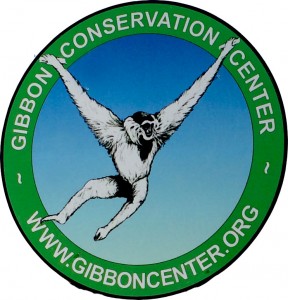 wonderful private tour of the largest conservation center for Gibbons in the western hemisphere. Gibbons are a delightful animal that my family knew very little about. But now, due in part to the dynamic tour guide Alma at the Gibbon Conservation Center (GCC), we feel like novice-experts. I believe, that is indeed the seed that every conservationists wishes to impart.
wonderful private tour of the largest conservation center for Gibbons in the western hemisphere. Gibbons are a delightful animal that my family knew very little about. But now, due in part to the dynamic tour guide Alma at the Gibbon Conservation Center (GCC), we feel like novice-experts. I believe, that is indeed the seed that every conservationists wishes to impart.  “The more you know,… the more you will care.” This couldn’t have been more evident, than in the middle of our tour, when our kids shared their desire to save the most endangered species of Gibbon in the wild, that are down to the last twenty in number. The children also discussed options on how to preserve habitats and still allow businesses to thrive that were presently devastating the homes of gibbons and other animals that live in jungles and forests. As a parent, I feel both pride and sadness over the responsibility that our children are taking to care for our planet. Points go to our tour guide for following the kid’s lead and dialoguing honestly and compassionately on this subject.
“The more you know,… the more you will care.” This couldn’t have been more evident, than in the middle of our tour, when our kids shared their desire to save the most endangered species of Gibbon in the wild, that are down to the last twenty in number. The children also discussed options on how to preserve habitats and still allow businesses to thrive that were presently devastating the homes of gibbons and other animals that live in jungles and forests. As a parent, I feel both pride and sadness over the responsibility that our children are taking to care for our planet. Points go to our tour guide for following the kid’s lead and dialoguing honestly and compassionately on this subject.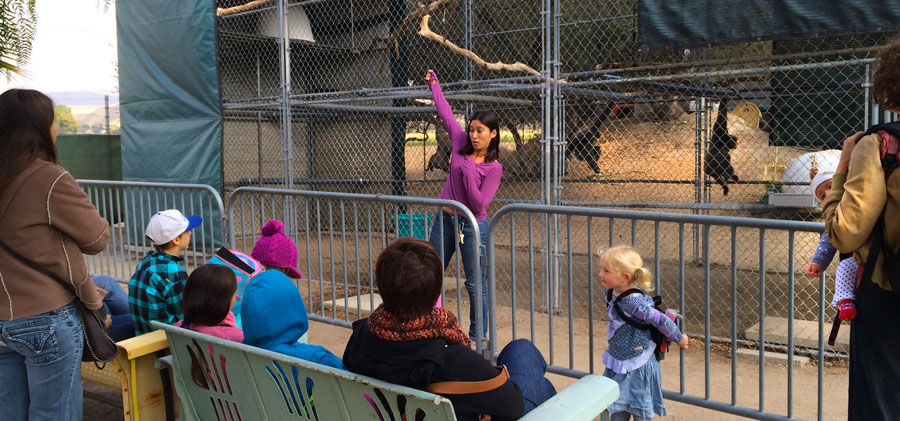
We can’t recommend this experience enough. Everyone in our group, age 1 year to 45 was engaged. Walking about the enclosures on such a lovely day, felt as if we were on National Geographic, observing beguiling primates swing and fly about in play as well as walk erect on the ground (looking more like humans than chimpanzees and great apes). And at the end of our tour, we experienced a crazy campus-wide concert of howling and crooning by most of the Gibbons, that I doubt any of us will ever forget. 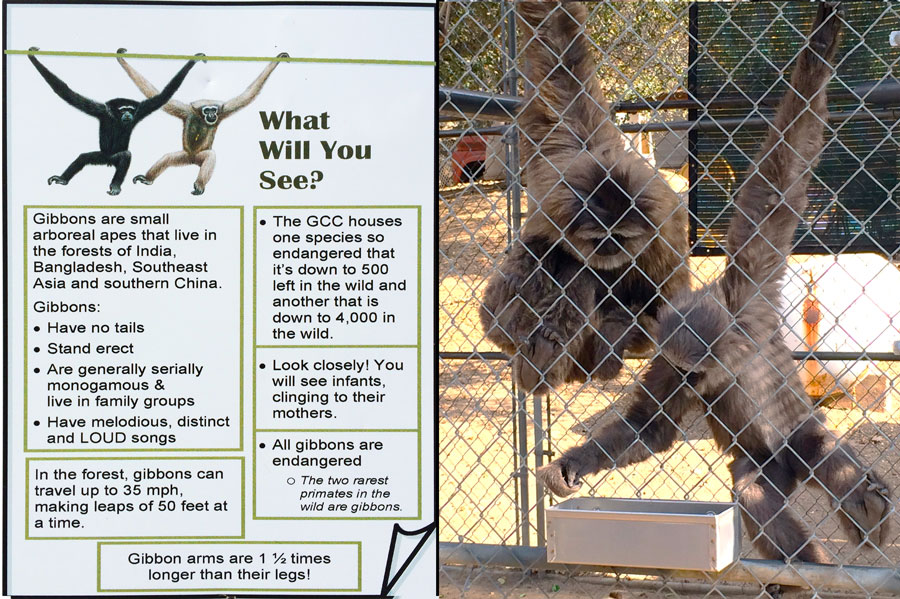 If you act quick enough, you can get tickets or private tours from Groupon at half price that will not expire until spring. Even though the center is open to the public on the weekends, it was well worth it to have the entire complex to yourself by purchasing the midweek private tour Groupon .
If you act quick enough, you can get tickets or private tours from Groupon at half price that will not expire until spring. Even though the center is open to the public on the weekends, it was well worth it to have the entire complex to yourself by purchasing the midweek private tour Groupon .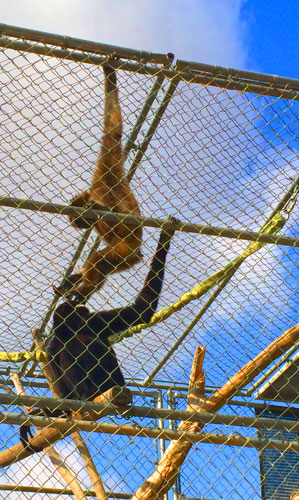
In addition to serving as a sanctuary since 1976 (when Gibbon specialist, Alan Mootnick founded it), the GCC presently works with governments and conservationists in Southeast Asia to aid in restoring the Gibbon populations. Extra care is taken to allow the Gibbon’s to exist as close to their natural state as possible in order to effectively reintroduce their offspring to their natural habitats. This means there is no man-handling beyond medical-required attention. The true habits and characteristics of the Gibbons are honored. For example, the enclosures do not have artificial grass, faux rocks or fake foliage (which appeals to humans). Instead they are structurally sound and interlaced with tree trunks, ropes and swings to best allow the Gibbons to fly, jump, spin and yank as hard as they would on trees and vines in the jungles and canopies of their indigenous habitats. And boy are their acrobatics a delight to behold.
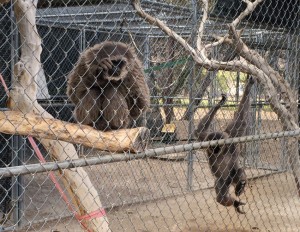 In the wild, Gibbons do not travel in large numbers. A pair of parents rearing their children is the traditional “band” of Gibbons. Their young are nursed from 2- 3 years and live with their parents in a family unit similarly to us. The youngest baby at GCC is seen in the lap of the orange Gibbon pictured above. He clung adorably to his mother as we watched her swing from her perch to pick up some greenbeans and place one each in her feet and free hand, before using the other hand to swing and maneuver herself back to her original perch to snack upon her green goodies. Around 18 years of age, the offspring are pushed out of the family unit to ideally start their own family and stake out their own territory.
In the wild, Gibbons do not travel in large numbers. A pair of parents rearing their children is the traditional “band” of Gibbons. Their young are nursed from 2- 3 years and live with their parents in a family unit similarly to us. The youngest baby at GCC is seen in the lap of the orange Gibbon pictured above. He clung adorably to his mother as we watched her swing from her perch to pick up some greenbeans and place one each in her feet and free hand, before using the other hand to swing and maneuver herself back to her original perch to snack upon her green goodies. Around 18 years of age, the offspring are pushed out of the family unit to ideally start their own family and stake out their own territory. 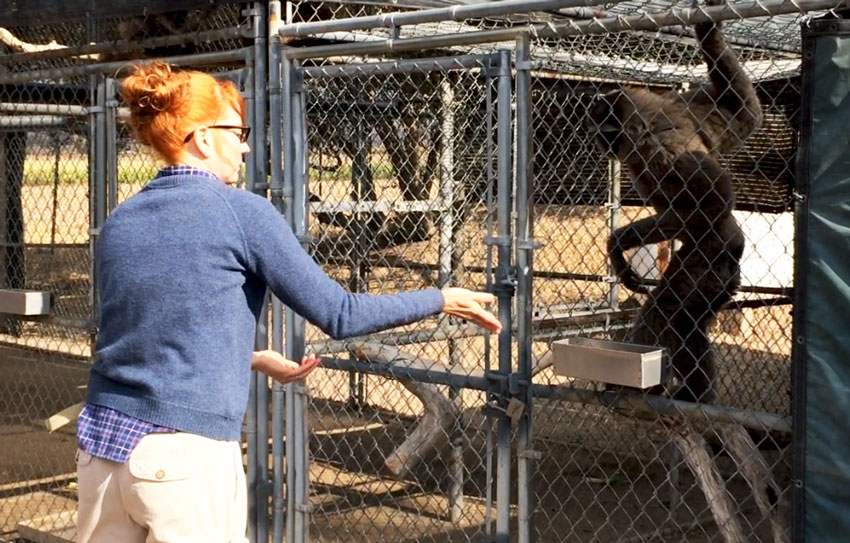 At GCC, each enclosure that houses a nuclear family is covered with tarps, not only to offer shade in the hot seasons, but to create visual camouflage allowing each Gibbon families a sense of separation like from foliage and canopies in the wild.
At GCC, each enclosure that houses a nuclear family is covered with tarps, not only to offer shade in the hot seasons, but to create visual camouflage allowing each Gibbon families a sense of separation like from foliage and canopies in the wild.
The life expectancy of a Gibbon is between 30 and 40 years, and yet the oldest Gibbon is now 40 and still alert and active. Once the youngest at the center, he is now the oldest. (Pictured sitting on the log while a younger descendent plays flies about). Unlike Zoos, that typically feed their animals twice a day, Gibbons at the center are fed TEN times a day, similar to their feeding and grazing styles in the wild. Their varied diet is continuously modified by the workers and volunteers, once receiving two bananas a day it has been cut down to one, where as yams have been increased and they are considering increasing their protein in the form of nuts. They spend over 2 thousand dollars a month on feeding these spectacular animals.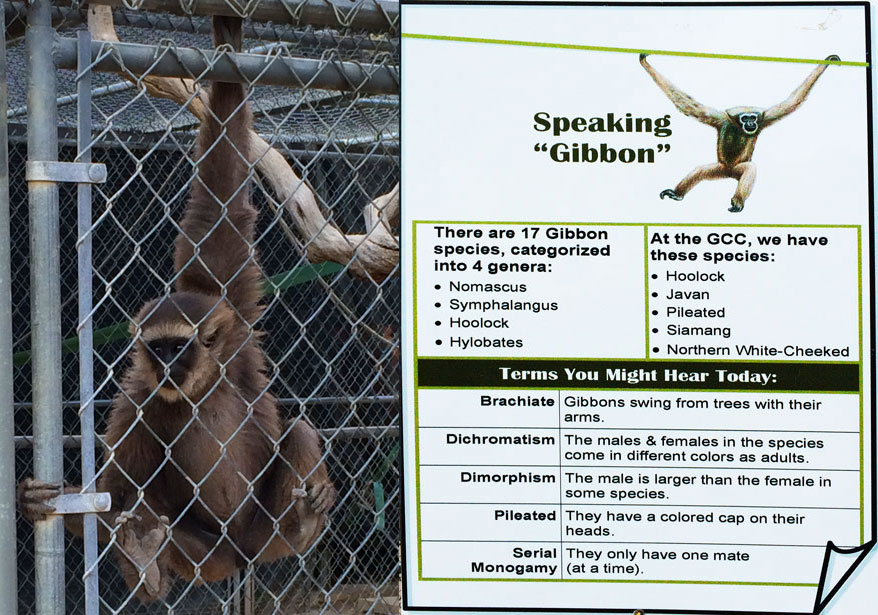
At the center, they have experimented with forms of entertainment and enrichment in the enclosures like swings, hammocks, and toys as well as some lovely drums on the grounds that our kids played upon.  Interestingly enough, as I looked around to see the reaction, the drumming didn’t do a thing for the Gibbons, but made us visitors dance a bit.
Interestingly enough, as I looked around to see the reaction, the drumming didn’t do a thing for the Gibbons, but made us visitors dance a bit.
Each volunteer and employee at the center are keen on observing habits, health and interests of these fascinating creatures in order to improve the life of Gibbons at GCC, as well as in sharing with the international consortium of sanctuaries, zoos and conservation areas to ensure that the 17 species of Gibbons have the best possible outcomes. Get your Groupon now, or just make a donation to the Gibbon Conservation Center that works so hard to protect these animals, build awareness around the globe and is ensuring these species will NOT go extinct. If you have never purchased a Groupon before, you can use this link and give me a referral bonus.
]]>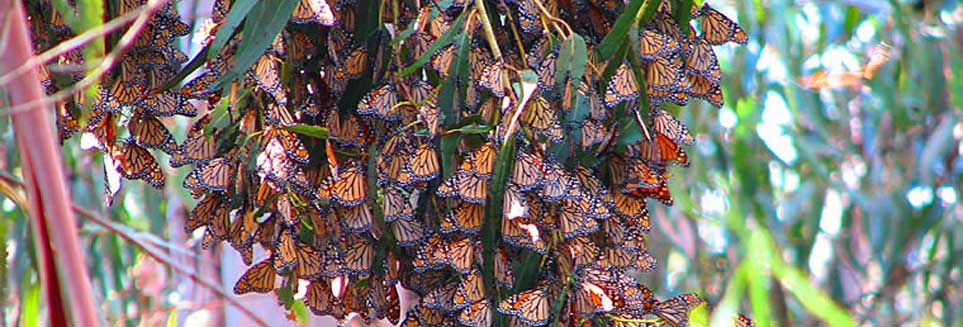 wintering-over or diapause (a bit like hibernation). What do they like to eat? Why do they fly thousands of miles. how long do they live? What can you do to make your yard more appealing to butterflies? We will also take a closer look at the horticulturist Cooper Ellwood who created one such grove
wintering-over or diapause (a bit like hibernation). What do they like to eat? Why do they fly thousands of miles. how long do they live? What can you do to make your yard more appealing to butterflies? We will also take a closer look at the horticulturist Cooper Ellwood who created one such grove

(planting 150,000 Blue Gum Eucalyptus trees) and spear-headed the eucalyptus foresting movement in CA. Let’s make some cool crafts to bring the “egg – caterpillar – chrysalis – butterfly” cycle to life.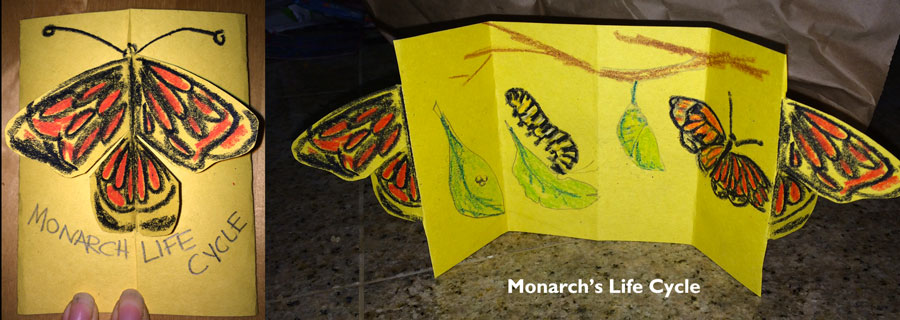
We will make mini-life-cycle books with a 3-D butterfly.  But I can’t wait to make live-action Monarchs.
But I can’t wait to make live-action Monarchs.  November 23rd 10:30 am – No need to go to Pismo
November 23rd 10:30 am – No need to go to Pismo  to see these gracious creatures in flaming masses. Two days after our parkday, meet up with my family Saturday morning, November 23rd for a close-up view of Migrating Monarchs at Ellwood Open Mesa in Santa Barbara County. We will meet at the Monarch Grove at 10:30 am and observe, sketch and play until we get hungry and walk to our picnic. The grove supplies docents from 11am-2pm to answer more of your questions.
to see these gracious creatures in flaming masses. Two days after our parkday, meet up with my family Saturday morning, November 23rd for a close-up view of Migrating Monarchs at Ellwood Open Mesa in Santa Barbara County. We will meet at the Monarch Grove at 10:30 am and observe, sketch and play until we get hungry and walk to our picnic. The grove supplies docents from 11am-2pm to answer more of your questions. 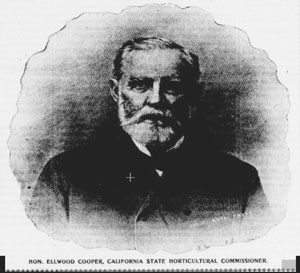
Afterward experience the trails all over the Ellwood Open Mesa to the ocean bluffs of Santa Barbara Shores County Park. We plan on having our picnic lunch there.
Bonus: I will share the fascinating history of horticulturist extraordinaire, Ellwood Cooper. 100 acres of the surrounding land was once all his. He planted 7,000 walnut trees and 150,000 Eucalyptus trees amongst others. He wanted to build forests in California instead of cutting trees down. Renowned in the states and abroad as the Olive Oil King, he was the 1st manufacturer of commercial olive oil in America and brought other innovations to his stone fruit, nuts and other crops. But it was his dedication to introducing his Eucalyptus to N. America that we owe gratitude. For that is what draws the Monarchs here annually.